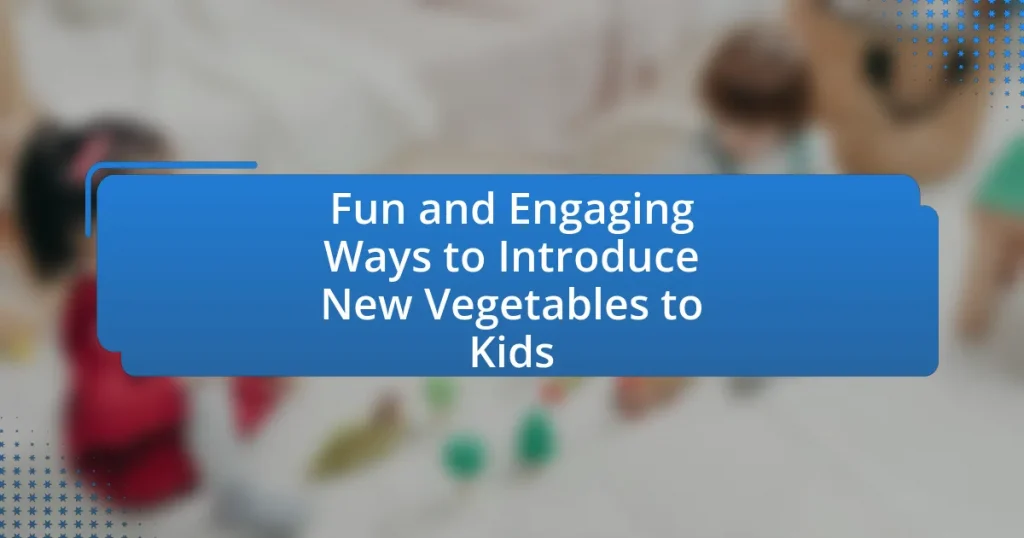The article focuses on fun and engaging ways to introduce new vegetables to children, emphasizing the importance of interactive cooking activities, vegetable-themed games, and creative presentations. It highlights the nutritional benefits of vegetables for kids, the impact of introducing new vegetables on their eating habits, and the challenges parents face in overcoming resistance to unfamiliar foods. Strategies such as involving children in meal preparation, using appealing presentations, and incorporating games are discussed as effective methods to enhance children’s willingness to try and enjoy a variety of vegetables. The article also addresses the role of peer influence and taste preferences in children’s acceptance of vegetables, providing practical tips for parents to create a positive mealtime environment.

What are Fun and Engaging Ways to Introduce New Vegetables to Kids?
Fun and engaging ways to introduce new vegetables to kids include interactive cooking activities, vegetable-themed games, and creative presentations. For instance, involving children in the cooking process allows them to explore different vegetables firsthand, which can increase their willingness to try them. Research shows that children are more likely to eat vegetables when they participate in meal preparation (Contento, 2011, “Nutrition Education: A Key to Improving Child Health,” Journal of Nutrition Education and Behavior). Additionally, using games like vegetable scavenger hunts or creating fun names for dishes can make vegetables more appealing. Presenting vegetables in colorful and visually appealing ways, such as in rainbow salads or vegetable art, can also capture children’s interest and encourage them to taste new options.
Why is it important to introduce new vegetables to children?
Introducing new vegetables to children is important because it promotes a balanced diet and encourages healthy eating habits. Exposure to a variety of vegetables helps children develop a taste for different flavors and textures, which can lead to better nutritional choices in the long term. Research indicates that children who are introduced to a wide range of vegetables are more likely to consume them regularly, thereby increasing their intake of essential vitamins and minerals. For example, a study published in the journal “Appetite” found that repeated exposure to new vegetables significantly increased children’s acceptance and consumption of those foods.
What are the nutritional benefits of vegetables for kids?
Vegetables provide essential nutritional benefits for kids, including vitamins, minerals, fiber, and antioxidants that support growth and development. For instance, vegetables like carrots are rich in vitamin A, which is crucial for vision and immune function, while leafy greens such as spinach offer iron and calcium, important for healthy bones and blood. Additionally, the fiber found in vegetables aids digestion and helps maintain a healthy weight, which is vital during childhood growth phases. Studies show that children who consume a diet high in vegetables are less likely to develop chronic diseases later in life, reinforcing the importance of incorporating a variety of vegetables into their meals.
How can introducing new vegetables impact children’s eating habits?
Introducing new vegetables can significantly enhance children’s eating habits by increasing their willingness to try diverse foods. Research indicates that repeated exposure to unfamiliar vegetables can lead to greater acceptance and preference for those foods, as demonstrated in a study published in the journal “Appetite” by Wardle et al. (2003), which found that children who were repeatedly offered a variety of vegetables were more likely to consume them regularly. This change in behavior can contribute to a more balanced diet, improved nutrition, and a reduction in picky eating tendencies.
What challenges do parents face when introducing new vegetables?
Parents face several challenges when introducing new vegetables to their children, primarily resistance to trying unfamiliar foods. Children often exhibit neophobia, which is the fear of new foods, making them reluctant to taste vegetables they have not encountered before. Research indicates that repeated exposure to new vegetables can increase acceptance; however, parents may struggle with the persistence required to encourage their children to try these foods. Additionally, parents often deal with the pressure of ensuring their children consume a balanced diet while navigating their preferences and aversions. This dynamic can lead to frustration and conflict during mealtimes, as parents attempt to balance nutrition with their children’s tastes.
How can taste preferences affect vegetable acceptance?
Taste preferences significantly influence vegetable acceptance, as individuals are more likely to consume vegetables that align with their established flavor profiles. Research indicates that children, for example, often reject vegetables that are bitter or unfamiliar, which can be attributed to innate taste aversions developed for survival purposes. A study published in the journal “Appetite” by Birch et al. (2007) found that repeated exposure to a variety of vegetables can enhance acceptance, particularly when these vegetables are paired with familiar flavors. This suggests that positive taste experiences can reshape preferences, making children more open to trying and accepting new vegetables.
What role does peer influence play in children’s vegetable consumption?
Peer influence significantly impacts children’s vegetable consumption by shaping their food preferences and behaviors. When children observe their peers enjoying vegetables, they are more likely to try and accept these foods themselves. Research indicates that social interactions among children can enhance their willingness to eat vegetables, as seen in studies where children who participated in group eating activities consumed more vegetables than those who ate alone. For instance, a study published in the journal “Appetite” found that children were more likely to increase their vegetable intake when they saw their friends eating them, demonstrating the powerful role of peer dynamics in dietary choices.
What strategies can make introducing new vegetables fun?
Introducing new vegetables can be made fun through interactive cooking activities, such as allowing children to participate in meal preparation. Engaging kids in the cooking process fosters curiosity and ownership over their food choices. Research indicates that children who help prepare meals are more likely to try new foods, including vegetables, as they feel a sense of accomplishment and connection to the dish. Additionally, incorporating games, such as vegetable-themed scavenger hunts or taste tests, can create excitement and encourage exploration of different flavors and textures. These strategies not only make the experience enjoyable but also promote healthy eating habits among children.
How can cooking together enhance children’s interest in vegetables?
Cooking together can enhance children’s interest in vegetables by making the experience interactive and enjoyable. When children participate in the cooking process, they are more likely to engage with the ingredients, including vegetables, fostering a sense of ownership and curiosity about their food. Research indicates that children who are involved in meal preparation are more inclined to try new foods, including vegetables, as they feel a connection to the cooking process. A study published in the Journal of Nutrition Education and Behavior found that children who helped prepare meals were significantly more likely to consume fruits and vegetables compared to those who did not participate in cooking activities. This hands-on experience not only increases familiarity with vegetables but also encourages positive attitudes towards healthy eating.
What are some creative presentation ideas for vegetables?
Creative presentation ideas for vegetables include arranging them into fun shapes, such as animals or flowers, using colorful dips to enhance visual appeal, and creating vegetable skewers for easy handling. These methods engage children by making vegetables visually interesting and interactive. Research indicates that visually appealing food presentations can increase children’s willingness to try new foods, as demonstrated in studies published in the Journal of Nutrition Education and Behavior, which found that attractive food arrangements significantly improved children’s consumption of fruits and vegetables.
How can games and activities promote vegetable consumption?
Games and activities can promote vegetable consumption by making the experience of eating vegetables enjoyable and interactive for children. Engaging children in cooking games, gardening activities, or taste-testing challenges can create positive associations with vegetables, encouraging them to try and enjoy these foods. Research indicates that children are more likely to consume vegetables when they are involved in the preparation process, as demonstrated in a study published in the Journal of Nutrition Education and Behavior, which found that children who participated in cooking activities were 50% more likely to taste and consume vegetables. Additionally, incorporating competitive elements, such as point systems or rewards for trying new vegetables, can further motivate children to increase their vegetable intake.
What types of games can encourage kids to try new vegetables?
Interactive cooking games can encourage kids to try new vegetables. These games often involve hands-on activities where children can prepare meals using various vegetables, making the experience fun and engaging. Research shows that children are more likely to taste and accept new foods when they are involved in the cooking process, as it fosters a sense of ownership and curiosity about the ingredients. For example, a study published in the Journal of Nutrition Education and Behavior found that children who participated in cooking classes were more willing to try new fruits and vegetables compared to those who did not.
How can gardening activities foster a love for vegetables?
Gardening activities can foster a love for vegetables by allowing children to engage directly with the growing process, which enhances their understanding and appreciation of food. When children plant seeds, nurture plants, and eventually harvest vegetables, they develop a personal connection to the food they eat. Studies show that children who participate in gardening are more likely to try and enjoy vegetables, as they feel a sense of ownership and accomplishment in their growth. For instance, a study published in the Journal of Nutrition Education and Behavior found that children who gardened increased their vegetable consumption by 1.5 servings per day. This hands-on experience not only educates them about nutrition but also instills a positive attitude towards vegetables, making them more likely to incorporate these foods into their diets.
What are some successful recipes that incorporate new vegetables?
Successful recipes that incorporate new vegetables include vegetable stir-fry, where a variety of colorful vegetables like bok choy, snap peas, and bell peppers are sautéed with garlic and soy sauce, making them appealing to children. Another effective recipe is vegetable quesadillas, which can include zucchini, spinach, and bell peppers mixed with cheese, providing a fun and interactive way for kids to enjoy new flavors. Additionally, smoothies that blend spinach or kale with fruits like bananas and berries can mask the taste of the vegetables while delivering essential nutrients. These recipes are successful because they combine familiar flavors with new ingredients, making them more acceptable to children.
How can smoothies be a fun way to introduce vegetables?
Smoothies can be a fun way to introduce vegetables by blending them with fruits and other ingredients to create a tasty and visually appealing drink. This method masks the taste of vegetables, making them more palatable for children who may be resistant to eating them whole. For example, incorporating spinach or kale into a fruit smoothie can provide essential nutrients without overwhelming flavors. Research indicates that colorful presentations and sweet flavors can enhance children’s willingness to try new foods, including vegetables, as they associate them with enjoyable experiences.
What are some kid-friendly vegetable snacks that are easy to prepare?
Kid-friendly vegetable snacks that are easy to prepare include carrot sticks with hummus, cucumber slices with ranch dressing, and bell pepper strips with guacamole. These snacks are not only simple to make but also appealing to children due to their vibrant colors and crunchy textures. For instance, carrot sticks provide a sweet flavor that many kids enjoy, while cucumbers are refreshing and hydrating. Additionally, bell peppers are rich in vitamins and can be served with dips that enhance their taste, making them more enticing for young eaters.
How can parents involve children in meal planning and preparation?
Parents can involve children in meal planning and preparation by encouraging them to choose recipes and ingredients, allowing them to assist in cooking tasks, and discussing the nutritional benefits of various vegetables. Engaging children in these activities fosters a sense of ownership and interest in healthy eating. Research indicates that children who participate in meal preparation are more likely to try new foods, including vegetables, as they feel a connection to the meals they help create.
What are the benefits of letting kids choose vegetables for meals?
Letting kids choose vegetables for meals enhances their willingness to eat them and fosters healthy eating habits. When children are involved in the selection process, they feel a sense of ownership and autonomy, which can lead to increased consumption of vegetables. Research indicates that children are more likely to try and enjoy vegetables they have chosen themselves, as evidenced by a study published in the journal “Appetite,” which found that children who participated in selecting their meals consumed more fruits and vegetables compared to those who did not. This engagement not only promotes better nutrition but also encourages positive attitudes towards healthy foods, setting the foundation for lifelong healthy eating behaviors.
How can children participate in cooking to increase their interest in vegetables?
Children can participate in cooking by helping to wash, peel, and chop vegetables, which actively engages them in the preparation process. This hands-on involvement not only makes them more familiar with different vegetables but also allows them to take ownership of their meals. Research indicates that children who are involved in cooking are more likely to try new foods, including vegetables, as they develop a sense of accomplishment and curiosity about the ingredients they have prepared. For instance, a study published in the Journal of Nutrition Education and Behavior found that children who participated in cooking activities showed increased willingness to taste and consume vegetables.
What are some practical tips for consistently introducing new vegetables?
To consistently introduce new vegetables, incorporate them into familiar dishes gradually. Start by mixing small amounts of new vegetables into favorite meals, such as adding spinach to pasta sauce or blending carrots into smoothies. Research indicates that repeated exposure to new foods increases acceptance; a study published in the journal “Appetite” found that children may need to try a new vegetable up to 10 times before they accept it. Additionally, involve children in the selection and preparation process, as participation can enhance their willingness to try new foods.
How can parents create a positive mealtime environment for trying new foods?
Parents can create a positive mealtime environment for trying new foods by fostering a relaxed and encouraging atmosphere. This can be achieved by involving children in meal preparation, which increases their interest in the food being served. Research indicates that children are more likely to try new foods when they have a role in the cooking process, as it enhances their sense of ownership and curiosity about the meal. Additionally, maintaining a no-pressure approach during meals, where parents model positive eating behaviors and express enthusiasm for new foods, can significantly influence children’s willingness to try unfamiliar items. Studies show that repeated exposure to new foods in a supportive setting can lead to increased acceptance over time.
What are some common mistakes to avoid when introducing new vegetables?
Common mistakes to avoid when introducing new vegetables include overwhelming children with too many options at once, which can lead to confusion and rejection. Additionally, forcing children to eat vegetables can create negative associations, making them less likely to try them in the future. Not involving children in the selection or preparation process can also diminish their interest and willingness to try new vegetables. Research indicates that children are more likely to accept new foods when they have a role in the cooking process (Birch, L.L., & Fisher, J.O., 1998, “Development of eating behaviors among children and adolescents”).


